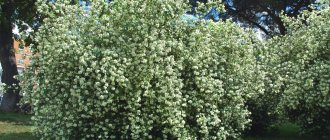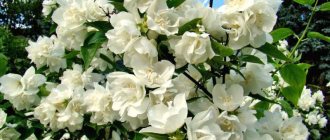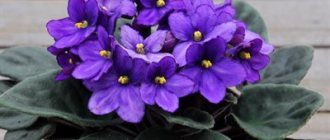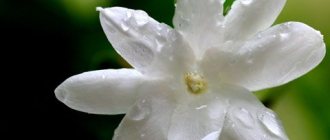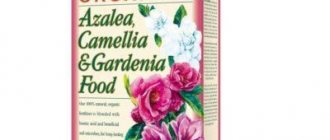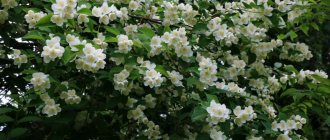Mock orange is one of the most common garden shrubs in the middle zone. The popularity of this plant is easily explained by its unpretentiousness and high decorative qualities. However, even undemanding crops need some care, and mock orange is no exception.
Due to its pronounced sweetish smell, garden mock orange is often confused with jasmine, and some even confuse these two plants, seriously believing that mock orange is the popular name for an eastern shrub. In fact, this is not the same culture; moreover, mock orange and jasmine are not even relatives!
Jasmine (Jasminum) is an evergreen shrub of the Olive family; in its natural environment it lives in warm zones and subtropics. It can be found especially often in South and Southeast Asia. At the same time, mock orange (Philadelphus) is a typical representative of the flora of the central and northern regions, and its closest relative is the long-known hydrangea, to which it belongs.
However, the habit of calling mock orange jasmine is firmly entrenched in the subconscious of domestic gardeners, so often in amateur and even professional circles this shrub continues to be called garden jasmine. Therefore, if you are going to plant one of these ornamental crops on your site, be sure to check the Latin name.
The shrub received its domestic name “mock orange” due to the fact that its hollow stems were previously used to make chibouks (parts of the bowl of a smoking pipe).
- The most beautiful varieties of mock orange - photos and descriptions
A selection of the best types and varieties of mock orange for the Moscow region and the middle zone.
Basic principles of caring for jasmine
Jasmine belongs to the category of unpretentious plants that can withstand temperature changes. There are no special requirements for lighting and soil. However, in order for the growth of the shrub to be stable, it is necessary to plant it in an area where there is no draft. You will also need to systematically moisten the soil and apply fertilizers for the jasmine so that the bushes are well-groomed and delight with lush flowering.
Note! Excessive moisture negatively affects the growth and development of the plant, so it is necessary to water the shrub often, but in moderation.
Features of reproduction
Virginal mock orange is usually propagated vegetatively:
- layering;
- dividing the bush;
- cuttings.
The easiest way to propagate Virgin mock orange is by layering. This process looks like this:
- In spring, a healthy shoot is selected from a bush and bent to the ground.
- The branch is securely fixed with a bracket and sprinkled with earth.
- In the fall, when the mock orange shoot takes root, it is transplanted to a new place.
Garden jasmine seeds of the Virgin variety are not bred. Firstly, this method is very labor-intensive. Secondly, it often leads to loss of varietal qualities.
Spring feeding of jasmine
Experienced gardeners recommend applying the first fertilizer for garden jasmine on May 10–15. To do this, you need to prepare a nutrient solution, which includes:
- superphosphate - 60 g;
- urea - 30 g;
- potassium sulfate - 30 g.
Pour 20 liters of water into a deep container and add the listed components to it. The prepared solution is used for spraying bushes in May and after the end of the flowering period.
Is it possible to grow mock orange in Siberia and the Urals?
Growing mock orange in Siberia and the Urals became possible after breeding varieties adapted to the cold winters of the region. In ornamental gardening in Siberia, about 30 varieties with a high frost resistance are used. These are mainly mock orange hybrids bred by breeder N.V. Vekhov.
Wild species bloom for a short time, tall shrubs - up to 4 m. Varietal representatives of mock orange with abundant long flowering time with double and simple flowers. The crown size ranges from dwarf to medium size. In Siberia, the crop is in high demand among gardeners. Grown as a design element for decorating plots and gardens. Mock orange is undemanding in agricultural technology, responds well to molding, grows quickly, and blooms 2 years after planting.
In Siberia, mock orange is grown to create a hedge. Included in a composition with roses, spirea, hydrangea. The shrub is planted near the wall of the building, along the perimeter of the rock garden, in the rock garden. Mock orange combines harmoniously with dwarf forms of conifers. The culture in Siberia remains decorative until late autumn; in September, the crown of garden jasmine turns bright yellow.
What fertilizers are suitable for jasmine
Not every fertilizer is suitable for jasmine. It is recommended to give preference to mineral and organic preparations intended for processing this shrub. Feeding plants with a solution containing calcium promotes abundant flowering. Below you can find the most suitable types of fertilizer for jasmine.
Organic fertilizers
For the harmonious growth and development of the shrub, lush and timely flowering, it is necessary to systematically enrich the soil with useful substances. Beginner flower growers often wonder how to feed jasmine in the summer? The most useful feeding during this period will be wood ash (0.1 kg per bush) or manure diluted in rainwater (1:10).
Mineral fertilizers
Jasmine bushes need mineral supplements. It is recommended to use as a fertilizer a solution containing water and superphosphate (1:5), urea (2.5 g) and potassium sulfate (2.5 g). After thoroughly mixing the components, the solution is poured under the jasmine bushes.
Complex fertilizers
During the budding period, plants need complex fertilizers. Using a similar fertilizer for jasmine promotes the formation of healthy leaf blades. Complex fertilizers for jasmine are applied at intervals. However, it is not recommended to use them more than once every 14 days. Most often, gardeners prefer Agricola, which is diluted in settled rainwater (5 g per 2 liters).
How to make mock orange bloom
In order for garden jasmine to delight you with its flowering, you must follow the basic rules for planting and care. The plant needs regular watering, timely weeding of the soil around the bush, and loosening the soil. It is advisable to plant the shrub in sunny areas with possible shading, where there is no constant stagnation of moisture.
Basic conditions for lush flowering.
- Fertilizer. Fertilizing with mineral fertilizers is carried out twice during the growing season. The first time is in the spring with the beginning of growth or at the moment of full bloom of the leaves. Presumably this is March-April. The second time is in the fall, starting from the last week of August until October. At the beginning of intensive growth of the bush, it is preferable to use nitrogen-containing preparations. During the formation and opening of flower buds, it is better to apply potassium fertilizers. Phosphorus compounds are added throughout the summer. Liquid fertilizers are considered the most effective.
- Trimming. At the end of June, garden jasmine should be pruned. Remove thickened shoots that grow inside the bush. Young shoots must be left in place so that the mock orange will bloom in the new season. Next year, in the spring, around March, it is worth thinning out the bush. Provided that it has grown greatly. We should not forget about rejuvenating the bush. Branches that are 10 or more years old should be removed at the root. By trimming the crown, there will be a powerful stimulation of the flowering and growth of mock orange.
- Most types of mock orange are frost-resistant. Even if the shoots freeze, they quickly recover. Shelter for the winter is not required. However, you need to take care of the root system before winter. The soil under the bushes is mulched with peat or pine needles with a layer thickness of 3-4 cm.
- At the moment of swelling of the buds, before and after the mock orange flowering period, it is recommended to carry out preventive spraying with insecticides and fungicides.
- If necessary, transplantation is carried out in early autumn or spring. First you need to water the bush generously and let it stand for 24 hours. Transplantation is carried out in the evening, after cutting off some of the dry shoots.
Fertilizing jasmine depending on the soil
Despite the fact that jasmine is not a capricious shrub, it is better to plant it on fertile loamy soil. By choosing the right place and providing the plant with proper care, you can grow healthy bushes that delight you with dense foliage and bright flowers. Before planting jasmine, you need to prepare drainage consisting of crushed stone, broken bricks, gravel and sand, which is placed at the bottom of the planting hole.
What to feed jasmine after flowering depends on the type of soil in which the crop grows.
- Sandy soil. It is recommended to feed jasmine with water-soluble nitrogen fertilizers. The solution can be prepared independently at home.
- Loamy soil, easy to cultivate and allowing sufficient heat, moisture, and air to pass through. You can enrich mineral-rich soil by watering the soil with a solution made from water and manure.
- Chernozem is a rich and fertile land, but it also requires the application of fertilizers, which contain potassium, phosphorus, peat and sand.
Species, hybrids, varieties
About 70 species of these deciduous shrubs with evergreen leaves or leaves that fall in winter are known.
Common types of mock orange:
- Common (Philadelphus coronarius) – the most popular species, is a garden shrub with intensely fragrant flowers;
- Fluffy (Philadelphus pubescens Loisel);
- Odorless (Philadelphus inodorus);
- Semi-umbrella (Philadelphus cymosus);
- Lewis (Philadelphus lewisii);
- Small-leaved (Philadelphus microphyllus).
Interesting interspecific hybrids:
- Falconera (Philadelphus falconeri);
- Maiden (Philadelphus virginal);
- Lemoine (Philadelphus Lemoine).
Ordinary
Mock orange (Philadelphus coronarius) is a shrub that blooms from May to June with strongly fragrant creamy white flowers. Suitable for single plantings and creating fragrant spring hedges. The plant reaches a height of 3-4 meters. Numerous varieties are characterized by different growth, flowering season and flower color. The view is extremely charming.
Below are popular varieties of common mock orange.
Aureus
Mock orange variety "Aureus" is distinguished by pale yellow leaves in spring, turning yellow in summer. The shrub blooms from May to June, adorning the bush with creamy white, highly fragrant flowers. Growing the variety is not difficult. The plant tolerates polluted city air and periodic droughts well. You can replant the bushes and carry out heavy pruning. Rejuvenating the plant every few years thanks to heavy pruning will help maintain the beautiful shape of the bush and abundant flowering. The "Aureus" variety is sometimes used for formed hedges, lines, group and single plantings.
Photo. Variety Aureus
Bell Etoile
This is a low variety - up to 1.5 m tall with straight shoots and single flowers with jagged edges of the petals.
Variegatus
Variegatus - a variety of mock orange with dark green leaves with a white edge
Grandiflorus (Philadelphus grandiflorus)
Chubushnik grandiflora jasmine is a wide shrub reaching a height of 3 meters. Among the dark green leaves on the arched shoots, large flowers with a diameter of 4-5 cm appear in June.
Photo. Philadelphus grandiflorus
Fluffy (Philadelphus pubescens)
The fluffy mock orange is a very growing species - up to 5 meters in height. The grey-green shoots and undersides of the leaves are covered with hairs. From June to July, the tree is decorated with single, large, odorless, creamy-white flowers. The species is suitable for tall green decorative hedges. Pruning will rejuvenate the plant and give the bush the correct shape.
Photo. Philadelphus pubescens
Attractive hybrids
Falconera (Philadelphus falconeri)
Falconer's mock orange is an interspecific hybrid, distinguished by arched shoots, on which graceful, fragrant, numerous flowers with four petals, collected in clusters, appear from May to June. Grown in gardens and public places.
Photo. Falconer's mock orange
Purple-spotted (Philadelphus × purpureomaculatus)
This is a densely branched shrub, distinguished by the original appearance of its flowers. Pink and purple spots appear at the base of the petals of the crown. Varieties vary in color:
- "Belle Etoile" - the flowers of the variety are wide-bellied, have a pink-violet spot at the base of the petals of the crown;
- "Etoile Rose" - bell-shaped flowers at the root, carmine pink.
Lemoine (Philadelphus × lemoinei Lemoine)
Mock orange Lemoine allows you to decorate your garden space with an attractive low shrub with a wide crown. Semi-double and double flowers appear among the tiny leaves. Popular varieties:
- "Erectus" - jasmine with single, strawberry-scented flowers;
- "Manteau d'Hermine" and "Dame Blanche" - varieties with semi-double flowers;
- "Boule d'Argent" - distinguished by double flowers.
Maiden's (Philadelphus × virginalis Rehder)
Maiden's mock orange is a fast-growing wide shrub reaching a height of 2 meters. Dark green leaves fall off in winter. From June to July the bush is decorated with white fragrant flowers. Flowers are collected in small clusters. The bush grows well in a sunny and slightly shady location, in moderately moist and loamy garden soil. After flowering, cut off old shoots. The plant is used for hedges, single and group plantings. Reproduction occurs from cuttings and root layering.
Photo. Maiden mock orange
Snowbelle
The garden jasmine variety Snowbelle or “Snowstorm” is an upright shrub reaching a height of 2 m. The leaves are dark green, slightly pubescent, and fall off in the winter. The flowers are large, white, double, 5-6 cm in diameter. They appear in large numbers from June to July.
Jasmine 'Snowbelle' prefers loamy garden soils that are moderately moist and have a slightly acidic, neutral or alkaline pH. Grows well in sunny and slightly shady locations. The plant is resistant to low temperatures and pests. The bush is pruned after flowering - in July. The bushes are impressively presented as formed and unformed green hedges, individually and in groups.
Kalina
Mock orange Viburnum is an attractive shrub with stiff stems, 2 meters high. It is distinguished by serrated light green leaves, among which four-petaled snow-white flowers with golden stamens appear in June and July. Magnificent inflorescences consist of several flowers - 5-9 pieces. Numerous flowers have an intense scent. It is best to grow jasmine in sunny or slightly shady areas.
"Kalina" prefers not too wet, loamy, fertile soils, and is resistant to frost and air pollution. Pruning after flowering allows you to rejuvenate the bush and give it the correct shape; the procedure is performed every few years. The plant creates beautifully formed hedges and looks attractive when planted singly or in groups.
General rules for applying fertilizers
In order for jasmine to bloom timely and lushly, it is important not only to properly care for the bushes, but also to choose the appropriate fertilizers.
Agronomists have developed general rules for applying fertilizing, according to which the grower must:
- systematically fertilize the soil;
- introduce and alternate different types of fertilizers (organic, mineral and complex);
- select fertilizers, taking into account the type of soil and plant variety;
- take into account the timing and norms of applying a specific solution;
- distribute useful elements evenly over the entire surface;
- Follow manufacturers' recommendations for the dosage of a particular drug.
Timing for applying fertilizer for jasmine
Regular application of fertilizers allows you to achieve lush and long-lasting flowering. At the end of spring, manure diluted with water in a ratio of 1:10 should be added to each jasmine bush.
Gardeners are often interested in how to fertilize jasmine in the summer so that it blooms profusely? In June, you need to apply mineral fertilizers to the soil, which contain:
- urea - 30 g;
- potassium sulfate - 30 g;
- superphosphate - 45 g;
- water - 15 ml.
Advice! In summer, jasmine is fertilized in the morning or evening.
As soon as the flowering period is over, it is recommended to add 150 g of wood ash to the tree trunk, this will promote good bud formation for the next year.
Description of the bush
Mock orange is naturally distributed in East Asia, North America, Southern Europe, and the Caucasus. This is a plant of the Hydrangeaceae family.
Mock orange is also known as jasmine, but this is a misnomer. It is confused with jasmine because of the sweet, pronounced aroma of flowers. The shrub is grown in gardens individually and in groups and is suitable for forming hedges. The plant is planted in city parks and industrial centers; the bush is resistant to air pollution.
White fragrant flowers appear among the oppositely arranged serrated leaves from May to July, depending on the variety.
Mock orange flowers are usually solitary and develop in the months of May-June. But there are varieties and hybrids with flowers:
- terry (for example, “Snowbelle”);
- semi-double (for example, “Virginal”).
There are low varieties:
- "White Dwarf", reaching approximately 1.2 m;
- "Erectus" - 1-1.5 m tall.
Interesting varieties with two-color or yellow leaves - for example:
- "Variegatus";
- "Innocence"
Some varieties have later flowering dates, for example in June-July:
- "Kalina"
- "Virginal"
The varieties listed above usually have a strong aroma, which, unfortunately, cannot be said about the fluffy mock orange (the lower part of the leaves is covered with delicate hair), which blooms in early summer (June-July) with numerous white, very beautiful flowers, but completely odorless.
The smell of mock orange is compared to the blossoming of citrus trees and, therefore, to the English name of the shrub - mock orange or fake orange.
Scheme for spring feeding of jasmine
How to feed jasmine in the spring to create a supply of nutrients? Experts recommend using:
- infusion, for the preparation of which manure is mixed with water (1:10);
- mineral fertilizers, which are applied to the soil at the end of May.
To prepare mineral fertilizer, you need to combine 4 liters of water, 6 g of potassium sulfide, 8 g of superphosphate and 6 g of urea in a deep container. The components are mixed. The prepared solution can be poured over 2 jasmine bushes. It is advisable to apply mineral fertilizing before the start of the active growing season.
Note! During flowering, the crop should be watered abundantly and the soil should be systematically treated with wood ash.
Mistakes gardeners make when applying fertilizers
Beginner gardeners often make mistakes when feeding jasmine bushes. The most common mistakes include:
- incorrectly calculated dosage. It is important to strictly follow the manufacturer’s recommendations when preparing the solution;
- violation of feeding deadlines. Above we indicated the preferred timing for applying fertilizers;
- use of drugs after the expiration date. The elements that make up fertilizers lose their beneficial properties over time, so feeding jasmine with expired fertilizer will be pointless;
- uneven distribution of the drug over the area. It is important to fertilize correctly to avoid a deficiency or excess of substances in a particular area of the soil.
Jasmine is an amazing shrub that delights with abundant and long-lasting flowering. This plant can become the highlight of a garden plot. But so that the crop does not lose its attractive appearance, it is worth feeding the bush correctly and developing your own schedule for fertilizing mock orange.
Preparing for winter
To prepare the plant for winter, it must be wrapped in agrofibre. But this is only relevant for young bushes. This is not necessary for mature plants. If frosts in winter are still quite strong, then you can mulch the area under the bush with any suitable material or peat.
If you still plan to tie it in agrofibre, then the branches must first be tied so that they are directed vertically upward and do not tear the material.
When there is heavy precipitation in the form of snow, the snow mass must be brought under the bush. This will provide protection from freezing of the root system.
Important ! As soon as the first thaw occurs, the shelter must be removed immediately.
Winter harness

